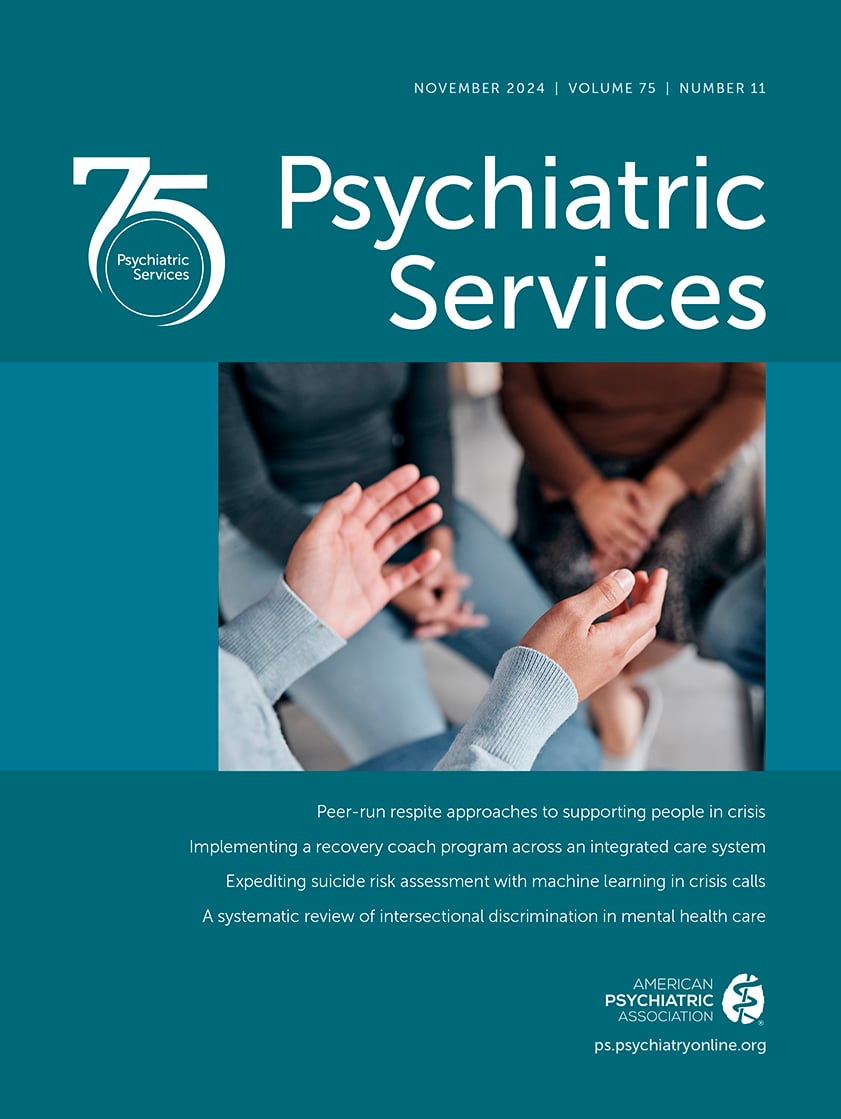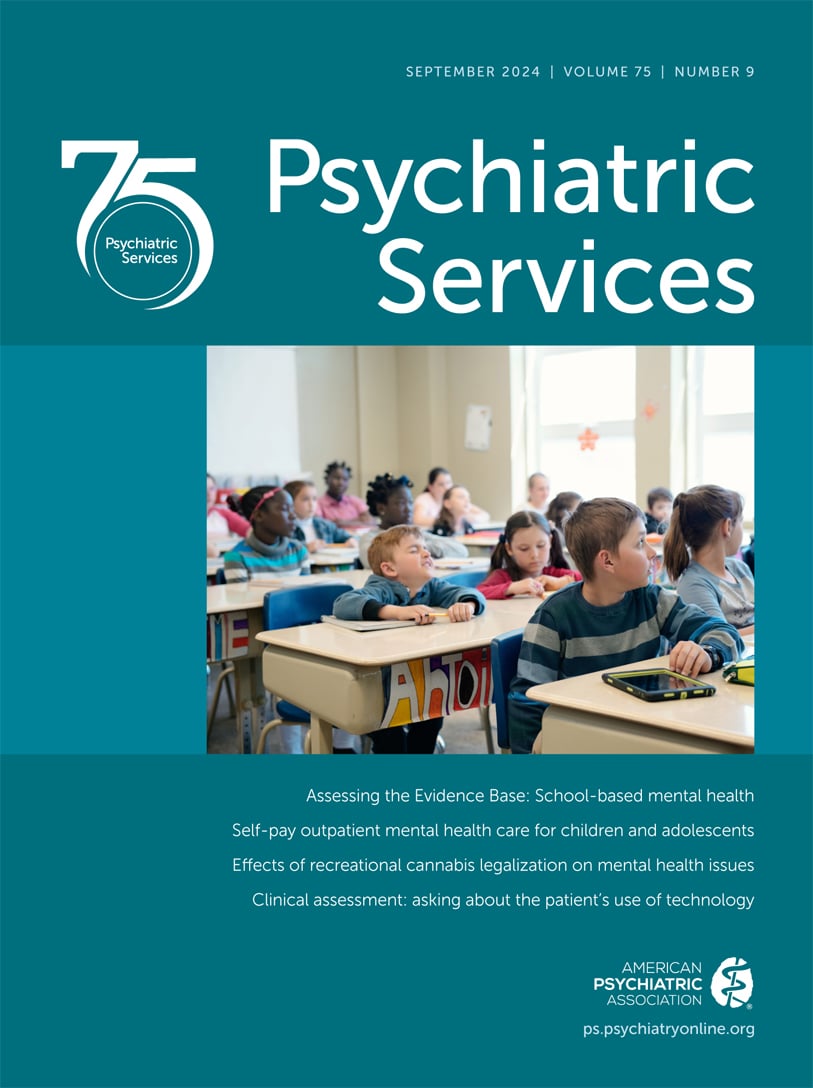Psychiatric Services
- Volume 50
- Number 5
- May 1999
Taking Issue
Column
Publication date: 01 May 1999
Pages615–618Introduction by the column editors: In the past three decades several clinical strategies for the treatment and rehabilitation of schizophrenia have been empirically validated. It is generally agreed that all persons with a schizophrenic disorder should ...
https://doi.org/10.1176/ps.50.5.615Publication date: 01 May 1999
Pages627–628Introduction by the column editor: Posttraumatic stress disorder (PTSD) has become a focus of increased clinical interest over the past decade, with the consequent development of a broader range of treatment modalities. Short- and long-range stressors, ...
https://doi.org/10.1176/ps.50.5.627Article
Publication date: 01 May 1999
Pages641–647OBJECTIVE: Persons with co-occurring severe mental illness and substance use disorders were followed for three years to better understand how they are involved with the legal system and to identify factors associated with different kinds of involvement. ...
https://doi.org/10.1176/ps.50.5.641Publication date: 01 May 1999
Pages648–652OBJECTIVE: The paper discusses issues related to the detection, prevention of transmission, and treatment of human immunodefiency virus (HIV) infection among persons with serious mental illness and suggests ways public mental health systems can address ...
https://doi.org/10.1176/ps.50.5.648Article on Care in the Least Well Off
Publication date: 01 May 1999
Pages653–658Funding for mental health services has declined in recent years, posing the difficult challenge of setting program and individual client service priorities with reduced resources. The author reviews seven principles for resource allocation and their ...
https://doi.org/10.1176/ps.50.5.653Publication date: 01 May 1999
Pages659–663Since the 1970s public mental health policy has given priority to the least well off—those with the most severe impairments and those who are most indigent. Reforms during this era have focused on the social welfare as well as the health and mental health ...
https://doi.org/10.1176/ps.50.5.659Publication date: 01 May 1999
Pages664–666The care of patients with serious mental illness, for whom a cure is unlikely and costs are high, is difficult to justify using ordinary standards of efficient resource allocation. The author examines the difficulties of using conventional utilitarian, ...
https://doi.org/10.1176/ps.50.5.664Other Article
Publication date: 01 May 1999
Pages667–673OBJECTIVE: The authors' goal was to identify factors that place inpatients with schizophrenia at risk of becoming homeless after hospital discharge. METHODS: Patients with schizophrenia or schizoaffective disorder (N=263) were assessed at discharge from ...
https://doi.org/10.1176/ps.50.5.667Publication date: 01 May 1999
Pages674–679OBJECTIVE: The study examined the influence of group or individual housing placement and consumer characteristics on the number of days subsequently homeless among formerly homeless mentally ill persons. METHODS: A total of 303 homeless shelter residents ...
https://doi.org/10.1176/ps.50.5.674Publication date: 01 May 1999
Pages680–685OBJECTIVE: Patient satisfaction ratings are increasingly being used as an indicator of quality of care. However, satisfaction scores do not account for differences in satisfaction among patients that may be attributable to sociodemographic characteristics ...
https://doi.org/10.1176/ps.50.5.680Publication date: 01 May 1999
Pages686–692OBJECTIVE: Empirical support for the effectiveness of group therapies for women with a history of childhood sexual abuse is scant. This study examined the feasibility of conducting abuse-focused research and group treatment on a short-term unit and ...
https://doi.org/10.1176/ps.50.5.686Brief Report
Publication date: 01 May 1999
Pages693–695Although consumers are increasingly hired as mental health workers, they typically fulfill demanding jobs such as case manager. This study examined the performance and job satisfaction of 18 consumers with serious mental illness who were hired for less ...
https://doi.org/10.1176/ps.50.5.693Publication date: 01 May 1999
Pages695–697Administrators and clinicians must find ways to effectively and efficiently use psychiatric resources without compromising the quality of care. The author outlines a model for setting benchmarks for allocating psychiatrists' time in a community mental ...
https://doi.org/10.1176/ps.50.5.695Publication date: 01 May 1999
Pages698–700The effectiveness of Israel's compulsory ambulatory treatment order was evaluated based on a one-year follow-up of the 326 orders served during the first four years of implementation. Demographic, epidemiological, clinical, and legal data were obtained ...
https://doi.org/10.1176/ps.50.5.698Publication date: 01 May 1999
Pages701–702The study assessed the experience, knowledge, and attitudes of parents of adolescents who had been treated with electroconvulsive therapy (ECT) about that treatment. Twenty-eight parents were interviewed. Overall, their opinions about ECT were favorable. ...
https://doi.org/10.1176/ps.50.5.701Letter
Book Review
Book Review: Women Speak About Their Illnesses
Book Review
News & Notes
Past Issues
View Issues Archive
Vol. 75 | No. 11

Vol. 75 | No. 10

Vol. 75 | No. 9
